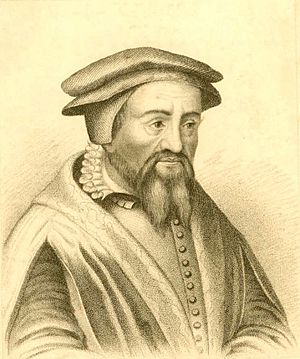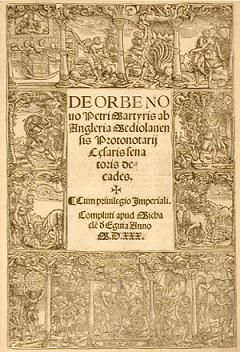Peter Martyr d'Anghiera facts for kids
Peter Martyr d'Anghiera (born February 2, 1457 – died October 1526) was an Italian historian. He worked for Spain during the exciting time known as the Age of Discovery. He wrote the very first stories about explorations in Central America and South America. He put these stories into letters and reports, which were later published in books called "decades."
His most famous work, De Orbe Novo (meaning "On the New World"), describes the first meetings between Europeans and Native Americans. It also tells about Native American cultures in the Caribbean, North America, and Mesoamerica. For example, it was the first European book to mention India rubber. His writings are very important for understanding the history of geography and discovery.
Life of Peter Martyr
Peter Martyr was born on February 2, 1457, near Lake Maggiore in Arona, Italy. He later took the name "d'Anghiera" from a nearby city. When he was 20, he moved to Rome and met many important people in the Catholic Church.
In 1487, he went to Zaragoza, Spain, with the Spanish ambassador. Peter Martyr quickly became well-known among the humanists in Spain. Humanists were scholars who focused on human values and achievements. In 1488, he even gave lectures at the University of Salamanca. He became a chaplain for the Spanish rulers, King Ferdinand and Queen Isabella.
After 1492, Peter Martyr's main job was to teach young nobles at the Spanish court. In 1501, he went on an important trip to Egypt. His mission was to convince the Sultan of Egypt not to harm Christians in Egypt and Palestine. This was because the Moors (Muslims from North Africa) had been defeated in Spain. Peter Martyr succeeded by explaining that no Muslims in Granada were forced to convert. He also promised Spain's help to Egypt against the powerful Ottoman Empire.
He wrote about his journey through Egypt in a book called Legatio Babylonica. This book was published with his Decades in 1511. After his successful mission, he was given the title maestro de los caballeros, meaning "master of knights."
In 1520, Peter Martyr became the official chronicler for the new Council of the Indies. This council was created by Charles V, Holy Roman Emperor to record events in the New World. In 1523, Charles V made him a Count Palatine. In 1524, he was again called to work for the Council of the Indies. He was also made the Abbot of Jamaica by Pope Clement VII. Even though he never visited Jamaica, he oversaw the building of the first stone church there.
Peter Martyr died in Granada, Spain, in 1526.
Peter Martyr's Writings
Peter Martyr wrote a lot! He wrote about 800 letters to famous people. These letters were like news reports, often sharing interesting gossip about events in Spain and the royal court. Since he was close to the court, he knew many important people. Historians have learned a lot about these people's looks and personalities from his letters.
His most important writing work was as a chronicler. He collected documents and stories from the explorers themselves. He also interviewed them in person. He read letters from Christopher Columbus and used reports from the Council of the Indies. He understood geography very well. He was the first European to realize how important the Gulf Stream was.
In 1511, he published the first historical account of the Spanish discoveries. It included his "Decades," which were ten reports. Two of these reports were letters he had sent earlier about Columbus's voyages. In 1501, he added eight more chapters about Columbus's journey and the adventures of Martín Alonso Pinzón. In 1511, he added a section covering events from 1501 to 1511.
Along with his "Decade," he published his travel story about Egypt. It described the people, their country, and its history. By 1516, he had finished two more "Decades":
- The first told about the adventures of Alonso de Ojeda, Diego de Nicuesa, and Vasco Núñez de Balboa.
- The second described Balboa's discovery of the Pacific Ocean, Columbus's fourth voyage, and the trips of Pedro Arias Dávila.
- These three "Decades" were published together in 1516 as De orbe novo decades cum Legatione Babylonica.
- The fourth "Decade" (1521) described the voyages of Francisco Hernández de Córdoba, Juan de Grijalva, and Hernán Cortés.
- The fifth "Decade" (1523) was about the conquest of Mexico and the circumnavigation of the world by Ferdinand Magellan.
- The sixth "Decade" (1524) shared stories of Dávila's discoveries on the west coast of America.
- The seventh "Decade" (1525) described the customs of native people in places like present-day South Carolina. It included the story of Francisco de Chicora, a Native American captured there. It also described people in Florida, Haiti, Cuba, and Darién.
- The eighth "Decade" (1525) told the story of Cortés's fight against Cristóbal de Olid, who tried to create his own state in Honduras.
All eight "Decades" were published together for the first time in 1530.
Peter Martyr also wrote a historical collection of letters called Opus epistolarum. This book was published after he died. It contains 812 letters to and from important church leaders, generals, and politicians in Spain and Italy. These letters talk about events between 1487 and 1525, especially the history of Spain.
See also
 In Spanish: Pedro Mártir de Anglería para niños
In Spanish: Pedro Mártir de Anglería para niños




